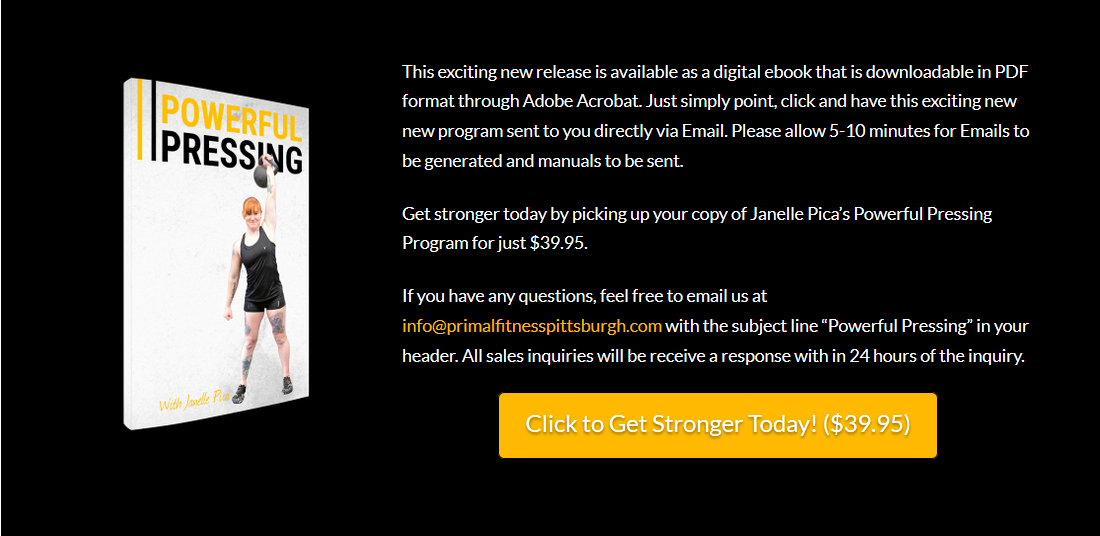There’s something to be said about the pistol squat for the level of strength the lift yields in the entire body. True, the one legged squat demands some serious strength in the legs themselves, but there is more to it than just moving your leg down and out of the bottom of your squat. In our previous series on the pistol squat, I have discussed the mobility drills necessary to facilitate this lift, I have discussed the nature of stability for the pistol squat, and I have gone as far as to show how strong a single loaded pistol can be when the aforementioned factors are in check.
Today’s post is a bit different. Today, I want to talk about upgrading your already stellar pistol squat and discuss how tweaking the types of pistol squats you do can lead to better overall strength. That being said, this post is for women who can pistol AT LEAST a 12kg on either leg and men who can pistol AT LEAST a 20kg on either leg. If this isn’t you, please refer to my previous posts that are linked in the above paragraph.
Let’s get to work!

Months ago, I was asked by none other than Coach Solo from Precision Nutrition about core stabilization for the pistol squat. “Tell me something” She said. “This isn’t all about the legs. . . right? You need a strong core to stabilize the weight in front of you. You just train more leg power as the weight increases, right?” DING DING DING! This is precisely the case! Don’t misunderstand the point here and think that the pistol HAS NOTHING to do with your legs, as you most certainly DO NEED leg power. However, core stabilization is a bit more important here in terms of the link up for the squat itself. Take a look at the diagram above. This diagram shows the link up of core stabilization and you legs. See the linkage into the glutes and quads? Well now. . .isn’t that something! I wouldn’t’ fret too much about extra core stabilization drills at the moment, as you can actually train core stability with the pistol itself in terms of how you grip the kettlebell.
First, let’s start with the basic pistol where the kettlebell is held in front of you.

You’ll notice in this photo that my grip on the 16kg is quite tight. In fact it is so tight on the bell my entire arm contracts. What’s interesting on this gripping tid bit is that gripping your kettlebell tightly causes a cascading effect in your body. Try this if you don’t believe me. Clench your fists tightly and pull your arms inward as if you are holding something in front of you? You may notice that your abs tighten and glutes contract immediately upon doing this. Neat. . huh? As you anchor yourself down into the bottom of the pistol, you’ll want to grip your kettlebell tighetly so engage your abs and glutes all the more. Pro tip: pretend as though you’re squeezing your kettlebell with everything that you’ve got. That will create enough tension to make your pistol squat easier to control.
Here’s a video demonstrating the pistol squat.
There are two ways to make this lift more challenging. Option 1) Rack grip pistol squat. Option 2) Bottoms Up pistol squat. First, let’s talk about the racked grip pistol squat.
If you clean your kettlebell and place it in the racked position, you will now have the additional demands of a contralateral load. Never fear, the same gripping drill applies here. Tightly grab your kettlebell while racked and gently lower yourself down. The closer you keep the kettlebell to your center of gravity, the less likely you will be pulled to the side by the counter weight. Your obliques will get some serious work on this one folks!
Lastly, is the bottoms up pistol squat. This, in my opinion, is the mother load of the pistol squat variations. You will be forced to grip your kettlebell with extreme tension to make sure the inverted weight does not topple over. You will also have to move slower than usual in order to control the inverted weight. While you will need maximal tension to move fluidly through this lift, this is about as close as you will get to maximum tension in a single lift. Trust me on this. The bonus of training the bottoms up pistol though is that it will make for some seriously powerful legs that will be able to move heavier weights through the pistol squat when they are not inverted. During the time I reached my 32kg pistol squat, I had intentionally placed bottoms up pistol squats with a 16kg into my training. Trust me folks! There is a freaky carry over with this one.
Just for kicks, here’s the double kettlebell versions of the racked and bottoms up pistol squat lifts. I know some of you out there are ready for this level of badassery so here you go! Please be ware that mastery of the above lifts are essential before moving into powerful leg work with double kettlebells.
Remember, a strong pistol squat is just as much about gripping your bell to engage more core stability as much as it is your leg power. You need all three pieces of the puzzle for this lift, and the more you practice these training tips, you’ll be on your way for effortless and super strong pistol squats!
That’s it for today folks! Until next time. .
Master your instincts!
